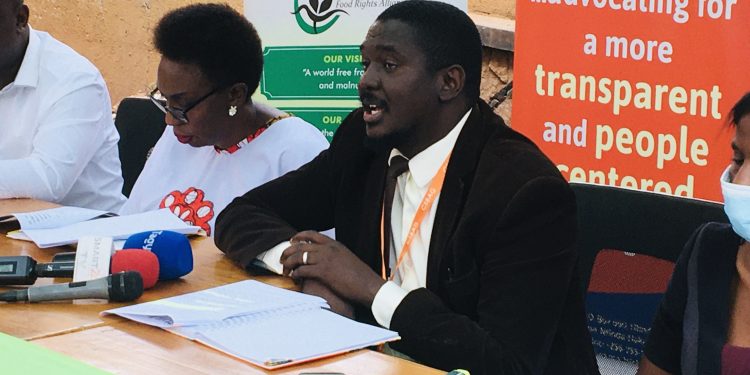Civil Society Organizations have tasked the government to find both short-term and long-term solutions for the skyrocketing prices of commodities.
They include; Civil Society Budget Advocacy Group (CSBAG), Action Against Hunger USA- Uganda, ACF USA-Uganda Mission, Forum for Women in Democracy (FOWEDE), Uganda Women’s Network (UWONET), Southern and Eastern Africa Trade Information and Negotiations Institute (SEATINI Uganda) and others.
According to the CSOs, since the re-opening of the economy in January 2022, the country has experienced an increment in commodity prices of up to 100% for some commodities.
While addressing a Press Conference at Food Rights Alliance (FRA) Secretariat in Mengo, Patrick Rubangakene, a budget specialist at CSBAG, said the government should come up with possible ways of reducing the ever-increasing Public Debt as this constrains its ability and effectiveness to finance the implementation and management of policy initiatives.
“The Monetary Policy Bank of Uganda Report (February 2022) revealed that public debt increased from UGX 69,722.4 billion in June 2021 to UGX 73,656.0 billion in December 2021 indicating a 5.6 percent increase,” he said.
“For example, laundry bar soap prices increased by 47.8%, cooking oil by 77.6%, and fuel by 34% in the past one year.”
He noted that the escalating poor Public Investments Management (PIM) must be well managed through effective and efficient systems since Uganda’s public infrastructure projects are largely funded by external donors.
He revealed that 342 projects worth UGX 39 trillion out of a sample of 371 projects reviewed had gone past their planned exit periods from the Public Investment Plan (PIP).
Agnes Kirabo, the Executive Director of Food Rights Alliance (FRA), noted with concern that agriculture being the leading sector catering to many Ugandans as well being seen as a vehicle of economic growth, needs critical attention if it is to effectively support the FY 2022/23.
Kirabo decried limited investment toward Water for Agricultural Production though Government increased the area under formal irrigation in FY2020/21 to 22,504 hectares which was higher than the set target of 19,776.
She, however, says CSOs are concerned about the delay in completing the irrigation master plan coupled with low budget allocation for small-scale irrigation at UGX 3.5Bn available out of the required UGX 23.5Bn (MAAIF, 2022/23) which undermines the realization of Pillar 1 of the PDM.
Namagga Imelda, a Budget Advocacy Advisor at Civil Society Budget Advocacy Group (CSBAG), showed concern about the low absorption of the wage budget by health facilities with the high level of vacant positions hence many health facilities failing to absorb the wage budget and funds returned to the Consolidated Fund.
“In the FY 2020/21, UGX 11 billion was returned by the Ministry of Health while Mulago Hospital returned over UGX 1 billion and on average, RRHs returned over UGX 0.5 Bn each,” she explained.
Emmanuel Kashaija, the Programs Manager at Forum for Women in Democracy (FOWODE), also highlighted the shortfall in Social Assistance Grant for Empowerment (SAGE) Budget that enables the elderly to access basic services and to start income-generating activities for sustenance.
However, the CSOs commended the government for taking some measures on the escalating prices as reflected in the statement by the Ministry of Finance on March 22, meeting timelines in this year’s budget processes as per the Public Finance Management Act, 2015 as amended and adopting some proposals by CSOs through engagement with Parliamentary Committees.
Rubangakene, said that according to the FY 2021/22 half-year Macroeconomic and Fiscal Performance Report, the economy is expected to grow at 3.8 percent in FY 2021/22 and is projected to grow at about maybe 6 percent in FY 2022/23.
According to the report, growth is expected to be generated by private sector activity due to increased aggregate demand post-COVID-19; increased returns from public infrastructure investments; and increased activities in the oil and gas sector.
The 6% growth translates to UGX 2,472.1 billion i.e. from UGX 44,778.80Bn in FY 2021/22 to UGX 47,250.9Bn in FY2022/23 of which 39.3% (UGX 18,582.6Bnn) of the overall budget will be for statutory expenditures while 60.7% i.e. UGX 28,668.3Bn will be appropriated for service delivery.








